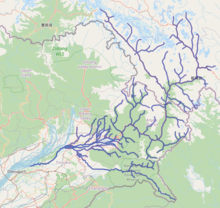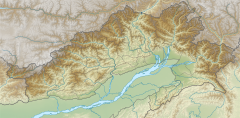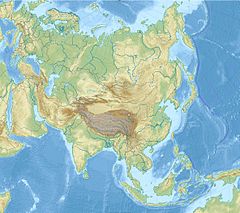| This article needs additional citations for verification. Please help improve this article by adding citations to reliable sources. Unsourced material may be challenged and removed. Find sources: "Lohit River" – news · newspapers · books · scholar · JSTOR (July 2011) (Learn how and when to remove this message) |
| Lohit River Zayü River | |
|---|---|
 Lohit River in Arunachal Pradesh Lohit River in Arunachal Pradesh | |
 Lohit River basin Lohit River basin | |
   | |
| Location | |
| Country | China, India |
| Province | Tibet, Arunachal Pradesh, Assam |
| Physical characteristics | |
| Source | Kangri Karpo |
| • location | Tibet, Zayu County, China |
| • coordinates | 29°09′46″N 97°05′01″E / 29.1629°N 97.0837°E / 29.1629; 97.0837 |
| • elevation | 5,200 m (17,100 ft) |
| 2nd source | Kangri Karpo |
| • location | Tibet, Zayu County, China |
| • coordinates | 29°27′47″N 97°08′12″E / 29.463°N 97.1366°E / 29.463; 97.1366 |
| Mouth | Siang (Brahmaputra) |
| • location | Assam |
| • coordinates | 27°48′N 95°28′E / 27.800°N 95.467°E / 27.800; 95.467 |
| • elevation | 108 m (354 ft) |
| Length | 560 km (350 mi) |
| Basin size | 41,499 km (16,023 sq mi) |
| Discharge | |
| • location | Confluence of Brahmaputra River, Assam, India |
| • average | 3,437.9 m/s (121,410 cu ft/s) |
| Discharge | |
| • location | Demwe Lower hydroelectric plant (basin size: 20,174 km (7,789 sq mi)), Arunachal Pradesh, India |
| • average | (Period: 1984/85-2003/04)1,234 m/s (43,600 cu ft/s) |
| • minimum | 263 m/s (9,300 cu ft/s) |
| • maximum | 4,273 m/s (150,900 cu ft/s) |
| Basin features | |
| River system | Brahmaputra River |
| Tributaries | |
| • left | Zuao, Gholum, Lati, Noa Dihang |
| • right | Dav, Delai, Tiding, Dibang |
The Lohit River, whose name came from the Assamese word Lohit meaning blood, also known as the Zayul Chu by the Tibetans and Tellu by the Mishmis, is a river in China and India, which joins the Brahmaputra River in the state of Assam. It is formed in the Zayul County of the Tibet Autonomous Region, through a merger of two rivers: the Kangri Karpo Chu (also called Rongto Chu and Zayul Ngu Chu), which originates in the Kangri Karpo range, and Zayul Chu (Chinese: 察隅河; pinyin: Cháyú Hé), which originates to its northeast. The two rivers merge below the town of Rima. The combined river descends through this mountainous region and surges through Arunachal Pradesh in India for 200 kilometres (120 mi) before entering the plains of Assam where it is known as the Lohit River. Tempestuous and turbulent, and known as the river of blood partly attributable to the lateritic soil, it flows through the Mishmi Hills, to meet the Siang (Brahmaputra) at the head of the Brahmaputra valley.
Course



Thickly forested for the most part, alpine vegetation gives way to subtropical forests, and then to some of the densest tropical jungles in all of India. Rhododendrons bloom in many hues in the upper reaches, orchids reveal themselves in the lower groves. This is indeed a treasure house of medicinal plant and herbs, and the home of Mishmi teeta, the coptis plant, prized the world over for its medicinal properties.
The Mishmis hold sway in the hills. In the plains are the Khamptis and the Singphos, fervent Buddhists and migrants from across the Patkai hills from Burma. As the Lohit journeys through, Tibetan theology gives way to animist belief, in turn replaced by Theravada Buddhism and then by Hindu temples. This region experiences a mix of many cultures near the tripoint between Tibet, Southeast Asia, and South Asia.
The Lohit river comes into India from China and flows near India's easternmost inhabited tip, at a place called Kibithu. The Indian Army uses this river for various expeditions and training.
The Dhola–Sadiya Bridge, also referred to as the Bhupen Hazarika Setu, is a beam bridge and longest in India, connecting the northeast states of Assam and Arunachal Pradesh. The bridge spans the Lohit River, from the village of Dhola in the south to Sadiya to the north.
River rafting
There have been very few raft expeditions on the Lohit River. It is a medium volume continuous Class 4+/5 river in its upper alpine reaches and becomes pool drop towards the latter end of the trip. Rafting was first started in February 1994 by the Indian Army and the first successful kayak descent of the river in December 2003.
Parshuram Kund, a Hindu pilgrimage is situated on the lower reaches of Lohit. Over 70,000 devotees and sadhus take holy dip its water each year on the occasion of Makar Sankranti, in the month of January.
See also
- Zayü County (in Tibet)
- Dhola–Sadiya Bridge
References
- ^ "Upper Brahmaputra".
- ^ "Lohit River Basin Study". 2009.
- Williamson, Noël (1909). "The Lohit-Brahmaputra between Assam and South-Eastern Tibet, November, 1907, to January, 1908". The Geographical Journal. 34: 363–383. doi:10.2307/1777190. JSTOR 1777190.
Tibetans call it the Zayul Chu, and the Mishmi name is Tellu
- Kingdon Ward, F.; Smith, Malcolm (November 1934), "The Himalaya East of the Tsangpo", The Geographical Journal, 84 (5): 369–394, doi:10.2307/1786924, JSTOR 1786924
- PTI (18 January 2013). "70,000 devotees take holy dip in Parshuram Kund". The Indian Express. Retrieved 13 January 2019.
- PTI (19 December 2012). "Arunachal Pradesh planning to promote tourism at Parsuram Kund". Daily News & Analysis. Retrieved 13 January 2019.